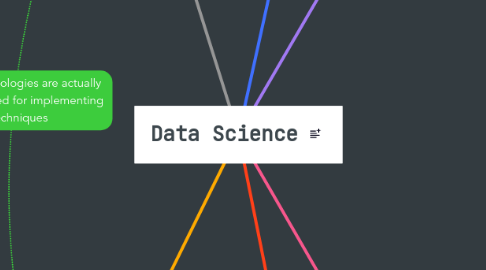
1. Data Mining
1.1. Data-Driven Decision Making
1.1.1. Beneficial Because...
1.1.1.1. Increased Productivity (4-6%)
1.1.1.2. Higher Return on Assets
1.1.1.3. Higher Return on Equity
1.1.1.4. Higher Asset Utilization
1.1.1.5. Higher Market Value
1.1.2. Types of Decisions
1.1.2.1. Discovery
1.1.2.1.1. Walmart and Scenario Based Inventory Management
1.1.2.2. Repeat
1.1.2.2.1. Customer Churn Prevention at MegaTelCO
1.1.2.3. Automated
1.1.2.3.1. IRS Audit Flags
1.1.2.3.2. Preliminary Credit Decisions
1.1.2.3.3. Automated Recommendations from Netflix or Amazon
2. Big Data
2.1. Big Data / Data Processing Technologies
2.1.1. Deals with
2.1.1.1. Handling of Data
2.1.1.1.1. Data Processing
2.1.1.2. Implementing Data-Mining Techniques
2.1.1.3. Storing Data
2.1.1.4. Not Decisions
2.1.1.5. Data Engineering
2.1.1.6. Too large for traditional storage solutions
2.1.2. Some "Big Data" Companies
2.1.2.1. Hadoop
2.1.2.2. Hbase
2.1.2.3. CouchDB
2.1.3. Benefits include
2.1.3.1. Increased productivity
2.1.3.2. Increases revenue
2.1.3.3. Decrease costs
2.2. We are in early stage of understanding and working with Big Data
2.2.1. Big Data 1.0
2.2.1.1. Firms focus on Processing Big Data
2.2.2. Big Data 2.0
2.2.2.1. Will focus on how that can use their Big Data resources
3. Fundamental Concepts of Data Science
3.1. Systematic Treatment
3.1.1. CRISP-DM & SaaS
3.2. Context is Important
3.3. Problem and Solution can be Decomposed
3.4. Informative Nuggets from Large Data Sets
3.5. Known & Unknown are Similer with Simlar Entities
3.6. Overfitting
3.7. Pay Attention to Compounding Factors
4. Draws from Traditional Fields
4.1. Causal Analysis
4.2. Statistics
4.3. Data Visualization
4.4. Other Soft Skills
4.4.1. Intuition
4.4.2. Creativity
4.4.3. Common Sense
4.4.4. Subject Knowledge
5. Industries and Uses of Data
5.1. Customer Relationship Management
5.1.1. Customer Churn Prevention
5.1.1.1. Example
5.1.1.1.1. Retention at MegaTelCO
5.2. Finance
5.2.1. Credit Scoring
5.2.2. Trading
5.3. Operations
5.3.1. Fraud Detection
5.3.2. Workforce Management
5.3.3. Supply Chain Management
5.3.3.1. Example
5.3.3.1.1. Walmart & Hurricane Charley
5.4. Marketing (Targeted)
5.4.1. Netflix
5.4.2. Amazon
5.4.3. Online Advertising
5.4.4. Cross-Selling Recommendations
5.5. Efficient Transaction Processing
6. Data-Analytic Thinking
6.1. Who needs it?
6.1.1. Line Employees
6.1.2. Managers
6.1.2.1. In Data Driven Companies
6.1.2.2. Outside of Data Driven Companies
6.1.3. Investors
6.1.4. Businesses
